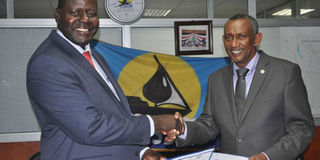Environmental issues at the core of implementing Lapsset project

LAPSSET Corridor Development Authority Director General Silvester Kasuku and Igad Secretariat Executive Secretary Mahboub Maalim, exchange documents after they signed the MOU on the detailed engineering Design of Lamu Port- South Sudan- Ethiopian Standard Gauge Railway line. PHOTO | FILE | NATION MEDIA GROUP
What you need to know:
Lapsset is a regional infrastructure programme that integrates seven projects, including roads, railway and pipeline in Kenya, South Sudan and Ethiopia.
In compliance with the Land Acquisition Act, compulsory acquisition and compensation of landowners was done in 2015.
Since its inception, the Lamu Port South-Sudan, Ethiopia Transport (Lapsset) Corridor project has always given serious attention to environmental concerns.
Our approach was borne out of the fact that a project of such a magnitude was definitely going to have an effect on the environment, both physical and social.
Lapsset is a regional infrastructure programme that integrates seven projects, including roads, railway and pipeline in Kenya, South Sudan and Ethiopia.
It is easily the single largest project of its kind in eastern Africa aimed at enhancing trade and logistics within the region. It is meant to provide an alternative and strategic corridor to serve the landlocked countries of Ethiopia and South Sudan.
A key component of the project is the construction of the first three of the 32 berths at Lamu Port. It is being done by the China Road and Bridge Corporation.
TERMINAL
The first terminal at Lamu Port, which is 40 per cent complete and is expected to be ready for commissioning in mid next year, has had environmental sensitivity at its core.
In 2014, the Lapsset Corridor Development Authority (LCDA) received approval and Environmental Impact Assessment Licences from the regulatory bodies before any work could start.
These were from Kenya Forest Service (KFS) and the National Environmental Management Authority (Nema).
The approvals were given to preserve the unique and bio-diverse ecosystem of Lamu as well as its status as a global cultural heritage site.
The LCDA also conducted a further Strategic Environmental Assessment (SEA) to incorporate social and environmental considerations in policies, plans and programmes. A number of socio-environmental considerations have been built into the project.
MARGINALISED
They include protection of marginalised communities; preservation of culture and heritage sites; zoning of protected areas such as water catchment areas, forest reserves and animal migratory routes; stakeholder participation and adequate compensation for affected persons.
In compliance with the Land Acquisition Act, compulsory acquisition and compensation of landowners was done in 2015.
The work includes dredging and land reclamation in the sea, inevitably affecting fishing. We have put in place mitigation measures, including an oceanographic assessment, whose aim is to have heavy construction only when the sea is calm to reduce sedimentation.
We have also set up “silk curtains” around the site to prevent the spread of sediments during construction, to protect coral life and fishing.
COMPENSATION
A detailed Resettlement Action Plan (RAP) was formulated to enable adequate compensation for landowners. A joint meeting between the boards of Kenya Ports Authority and LCDA on February 28, this year, called for a task force on fishermen compensation to work out the finer details.
A task force comprising Lamu County, LCDA and KPA officials was also formed. It held a meeting with Beach Management Units (BMUs) on July 14, where compensation methods were outlined.
They include provision of deep-sea fishing gear; establishment of fish storage and ports, a fish industrial park and terminal fish holding facilities.
ECONOMIC ZONE
The assistance of nearly 7,000 fishermen with modern equipment and boats that allow them to explore richer ground in deeper seas and a supportive infrastructure rather than cash to individual.
This is a more sustainable approach. This will be administered through cooperatives. Also planned is a fish factory in the proposed Special Economic Zone.
The economic power of Lapsset, a Vision 2030 project, cannot be gainsaid. Besides creating a second trade corridor in the region, it will also open up 70 per cent of our country for economic activity as we preserve our environment and the livelihoods of our people.
Mr Kasuku is the director-general/CEO, Lapsset Corridor Development Authority. [email protected]




